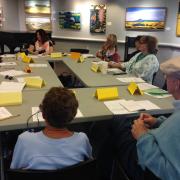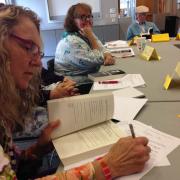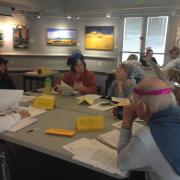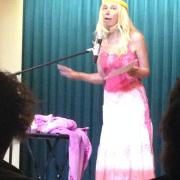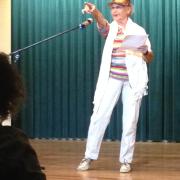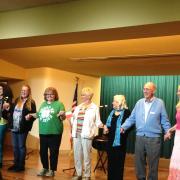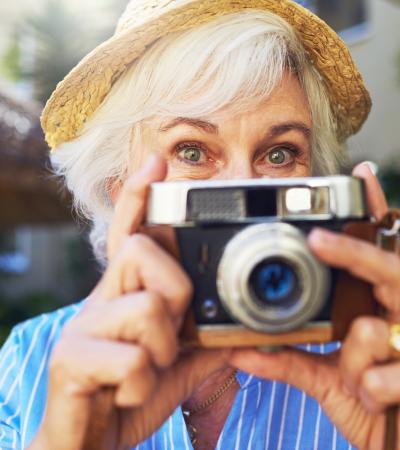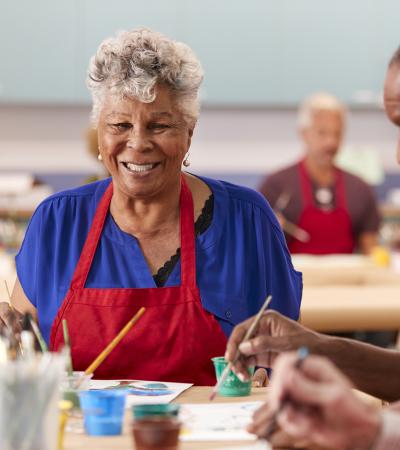Editor’s note: This Program Model is part of a series highlighting the work of the Lifetime Arts Affiliates, a cohort of 20 libraries that has been working with Lifetime Arts Inc. to launch professionally conducted arts education for older adults. For more information, check out Lifetime Arts' Creative Aging Toolkit for Public Libraries, a free online resource for librarians that provides information about creative aging research, best practices and practical advice for planning and implementing creative aging programs.
The Memoir Showcase Workshop was an eight-week series of sequential classes at the San Diego Public Library's Pacific Beach/Taylor Branch in which older adults learned about the craft of writing so they could transform the stories of their lives into written memoir pieces. The program culminated in a special finale event where each participant performed a brief theatre piece, dramatizing what they’d written.
Advanced Planning
Our goal was to engage older adults (55 and older) in an art-based instructional series of classes. The Pacific Beach/Taylor Branch Library was one of four San Diego Public Library branches awarded this grant, so I worked closely when planning our program with the other branch managers, as well as consulting with Lifetime Arts staff. The administrators at Lifetime Arts offered several webinars as well as an in-person institute to support participating librarians.
The library already offered several programs for older adults, so in June 2014 we surveyed them about which artistic disciplines they wanted to study. Pacific Beach was the only community expressing a strong interest in memoir writing, so we chose that. At the institute in October 2014, I participated in a mini-version of a memoir class with an acting component that I found to be emotionally powerful; that strengthened my resolve to craft a similar experience for our participants.
I was extremely fortunate in that the director of a local writing organization referred me to a writing instructor with experience in stagecraft.
One challenge when planning this event was that, because we wanted to stagger our system’s offerings, there was a year-long gap between attending the institute and when I finalized plans for my branch’s program.
Marketing
Immediately after the institute in October, I eagerly talked up the creative aging programs to everyone who I thought might be interested in taking an arts-based class. However, it wasn’t until February 2016 that I had finalized the details and could distribute a flier to promote my branch’s Memoir Showcase Workshop (see fliers under Attachments at right). I promoted our series digitally, with print and through word of mouth by doing the following:
- Adding the workshop to our monthly calendar of events
- Sending emails to my branch's mailing list
- Posting on the websites for both my branch and the library's system
- Posting on my branch’s Facebook account
- Posting on NextDoor
- Announcing the workshop at all of my branch's other programs for older adults
- Including it in a presentation to our Kiwanis club
- Chatting about it with customers
- Sharing the flier with our teaching artist who announced the clas to her other writing students
I wanted 10 to 15 participants, so it worked out well. We briefly had a waiting list, but a few people dropped out upon discovering that there was an acting component to the culminating event, and some had other commitments. We ended up with 10 artists participating.
Budgeting
We spent just under $2,000 for the teaching artist, including planning and preparation. We also purchased copies of a book on writing, which we gave to each participant in the class. Our system’s major cost-share contributions were for the room use fee (what we would have charged if a private group had rented the room for this class) and staff hours.
Day-of-event Activity
The class was composed of eight weekly sessions, each two hours in length. My staff set up tables and chairs in our community room before the teaching artist and students arrived. I sat in on the entire first session to answer any questions about why we were offering this particular program and our goals. I enjoyed getting to hear from the participants about why they’d decided it was time to capture their life’s stories on paper.
The teaching artist assigned homework each week to the participants. Initially it involved reading chapters from the book that they were all given, then completing writing exercises. In later weeks, they were tasked with writing memoir pieces that they would then share and discuss during class. Finally, they began focusing on one of their pieces and began to develop it for presenting on stage.
One unexpected challenge involved the venue for our culminating program. I had reserved a theater space before we began, but the time did not work for some students. Fortunately another student referred me to the theater at a local retirement community, which was available at a better time and even rented it to us for free.
Program Execution
Our culminating experience was a performance on stage, followed by a reception with light refreshments. Each participant read their piece aloud. They used at least one prop as a costume or to set the scene; some were more elaborate.
Their theme was “How Did I Get Here?,” and some of the pieces were quite personal. Three of them talked about abusive childhoods. Since they were so personal, I did not widely publicize the final event. Instead, I printed tickets for each participant to use as invitations for their family and friends. The program was also open to residents at the retirement community whose theater we were using. Including performers, 50 people attended the event.
Several of the participants told me later that they found the performance to be cathartic. One had vowed from the beginning that she wouldn’t invite anyone to the finale, and only days before the show called the instructor in a panic to say that she couldn’t share her story on stage. She did it, and even invited her sister. That night the sister learned that our artist had been sexually abused as a child, and after 50 years of silence they opened a new dialogue.
Lifetime Arts provided surveys for participants and the finale event’s audience (see surveys under Attachments at right). Some highlights were that 100 percent of the participants surveyed said they would recommend this program to a friend or family member, and 100 percent plan to continue writing. Moreover, all of them said that they would come to more creative aging programs at the library, and that attending these workshops improved their relationships with the library. Their feedback included:
- "I love "Our Class." The new friends I've made are WONDERFUL."
- "I feel more connected."
- "I enjoyed this so much, I drove 30 minutes each time to get to the group meetings."
- "I plan to write a book."
- "Really exciting class & wonderful community feeling."
- "I intend to finish at least one memoir for publication plus one for family history."
- "Good for cleansing the soul."
Advice
Surveying in advance was crucial for us. Without surveying, I would not have known that my community was particularly interested in memoir writing.
The next critical element is hiring the right teaching artist. I thought we were lucky when we found a writing instructor who also had theater experience. On top of that, though, she had experience working with aging populations and was even a licensed therapist. This came in handy since several of the participants chose to explore emotionally sensitive stories. I don’t believe our program would have been as transformative for our artists if we had employed a different instructor.
Finally, be open to supporting the group’s journey. I was worried when one day I heard them rehearsing some rather harrowing stories. I feared that they would feel emotionally naked in front of an audience. Had I been sitting in on all of the sessions I might have tried to encourage them to take a less risky path. However, these were the tales what they chose to share. They were bravely confronting and owning their stories. I had to respect them enough to trust that they were making the right choices for themselves.
Supporting Materials
- Feedback (Coming Soon!)
- Programming Librarian Facebook Group

